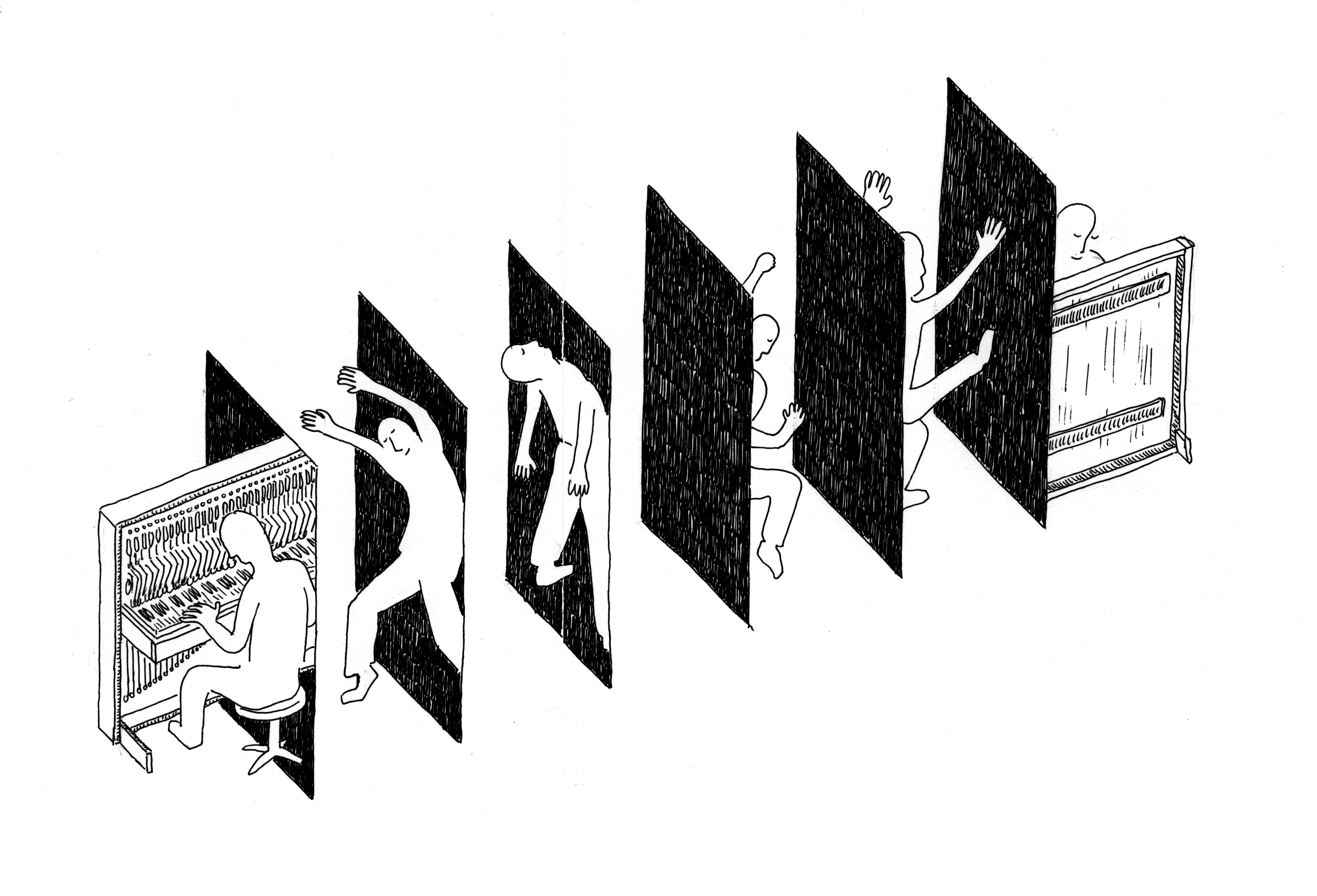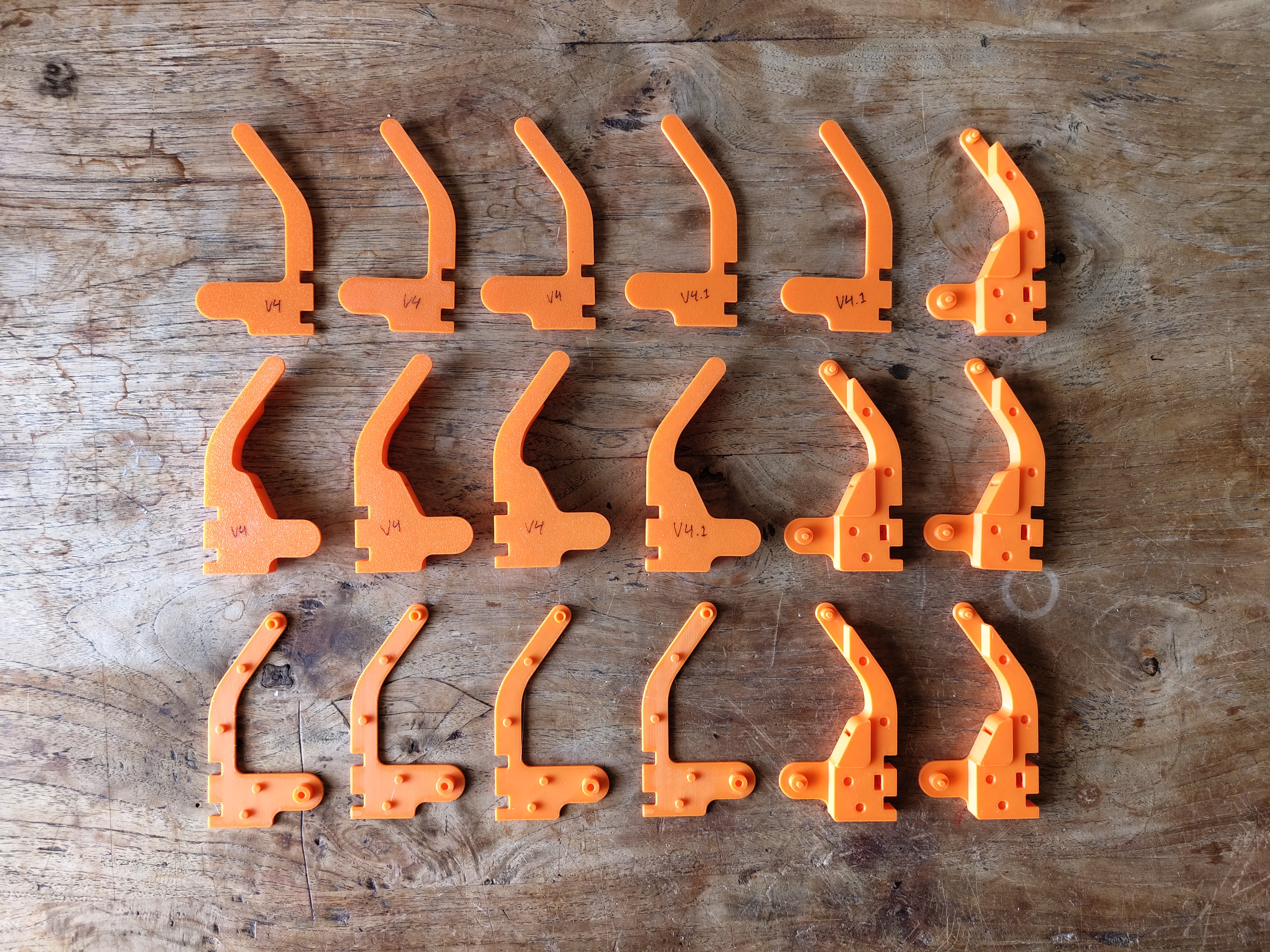Counterpoint:
Designing a piano in motion
–
Daniel Hooglandt
Designing a piano in motion
–
Daniel Hooglandt
‘In music, counterpoint is the combination of two or more independent voices, harmonically related but differing in rhythm and contour.’ 1
This project is a love letter to the piano. Over the past eighteen years I have fostered a deep connection with this magical instrument, leading me to explore the piano from the perspective of both designer and musician. With Counterpoint, I propose a new family member to join the long lineage of pianos. This electric piano prototype uses simple mechanics and a transparent design to allow the playing of not only the exterior of the piano (the keys), but also the interior (the strings). This is an invitation into the innards of the piano, a desire to both broaden the scope of the instrument and to encourage hands-on experimentation during play. The journey that this piano took me along led me to question the role of a designer within the relatively conservative field of classical instrument design. I documented this journey in a comic book, reflecting on my personal history with the piano and the people I met along the way.
![]()
Looking at existing piano designs, it became clear to me that designers often take on the role of coating existing objects with a layer of aesthetic ‘design sauce’. The core of the piano has remained mostly the same throughout the latter half of the instrument’s existence; new piano models differ only superficially in appearance and are the same under the hood. This fundamental consistency is largely essential for preserving classical music, the primary musical genre from which the piano originated.
![]()
Pianos were among the first instruments to be industrially produced, their repetitive design making them suitable for mass production. This transformed them from luxury items for the wealthy into household staples for the middle class in early 20th-century Western Europe. The piano became a symbol of social status, Victorian values, and the eligibility of women for marriage. Over nearly two centuries, the evolution of piano design and musical etiquette has produced a finely tuned system of values: A culture of disciplined practice; formal rules regarding proper playing technique and posture; a strong respect for traditional craftsmanship; a tender way of handling the piano; and a concert tradition marked by a preference for black attire, a standardised repertoire, and performers maintaining a professional demeanour on stage.
![]()
While the piano is an instrument I have grown to love deeply, I aim to expand its family with an instrument that is more focused on improvisational music. A piano that challenges the conservatism of the original instrument by removing its protective outer shell and condensing its mechanism, while retaining the fundamental elements (strings, hammers, keys). In the spirit of John Cage, Aphex Twin, Henry Cowell, and Jameszoo, Counterpoint is an instrument to be experimented with, to be broken down and rebuilt, to be modified and disturbed. It is a piano redesigned not just on an aesthetic level, but at its core. This core is designed to be in constant motion, as opposed to the timeless consistency of a conventional piano.
![]()
Reflecting on my time at the KABK, I realise that the development of my practice mimics the aforementioned story of the piano. When arriving at the Master Industrial Design department, my conception of design was as static as the piano. Coming from an educational background in philosophy, the transition to art school brought about a shift from a somewhat impersonal and formal educational environment to one that is significantly more personal and intimate. I've come to believe that for designing musical instruments, a design practice should mirror the flexibility and fluidity inherent in the music they will eventually produce.
![]()
This project is a love letter to the piano. Over the past eighteen years I have fostered a deep connection with this magical instrument, leading me to explore the piano from the perspective of both designer and musician. With Counterpoint, I propose a new family member to join the long lineage of pianos. This electric piano prototype uses simple mechanics and a transparent design to allow the playing of not only the exterior of the piano (the keys), but also the interior (the strings). This is an invitation into the innards of the piano, a desire to both broaden the scope of the instrument and to encourage hands-on experimentation during play. The journey that this piano took me along led me to question the role of a designer within the relatively conservative field of classical instrument design. I documented this journey in a comic book, reflecting on my personal history with the piano and the people I met along the way.

Looking at existing piano designs, it became clear to me that designers often take on the role of coating existing objects with a layer of aesthetic ‘design sauce’. The core of the piano has remained mostly the same throughout the latter half of the instrument’s existence; new piano models differ only superficially in appearance and are the same under the hood. This fundamental consistency is largely essential for preserving classical music, the primary musical genre from which the piano originated.

Pianos were among the first instruments to be industrially produced, their repetitive design making them suitable for mass production. This transformed them from luxury items for the wealthy into household staples for the middle class in early 20th-century Western Europe. The piano became a symbol of social status, Victorian values, and the eligibility of women for marriage. Over nearly two centuries, the evolution of piano design and musical etiquette has produced a finely tuned system of values: A culture of disciplined practice; formal rules regarding proper playing technique and posture; a strong respect for traditional craftsmanship; a tender way of handling the piano; and a concert tradition marked by a preference for black attire, a standardised repertoire, and performers maintaining a professional demeanour on stage.

While the piano is an instrument I have grown to love deeply, I aim to expand its family with an instrument that is more focused on improvisational music. A piano that challenges the conservatism of the original instrument by removing its protective outer shell and condensing its mechanism, while retaining the fundamental elements (strings, hammers, keys). In the spirit of John Cage, Aphex Twin, Henry Cowell, and Jameszoo, Counterpoint is an instrument to be experimented with, to be broken down and rebuilt, to be modified and disturbed. It is a piano redesigned not just on an aesthetic level, but at its core. This core is designed to be in constant motion, as opposed to the timeless consistency of a conventional piano.

Reflecting on my time at the KABK, I realise that the development of my practice mimics the aforementioned story of the piano. When arriving at the Master Industrial Design department, my conception of design was as static as the piano. Coming from an educational background in philosophy, the transition to art school brought about a shift from a somewhat impersonal and formal educational environment to one that is significantly more personal and intimate. I've come to believe that for designing musical instruments, a design practice should mirror the flexibility and fluidity inherent in the music they will eventually produce.
